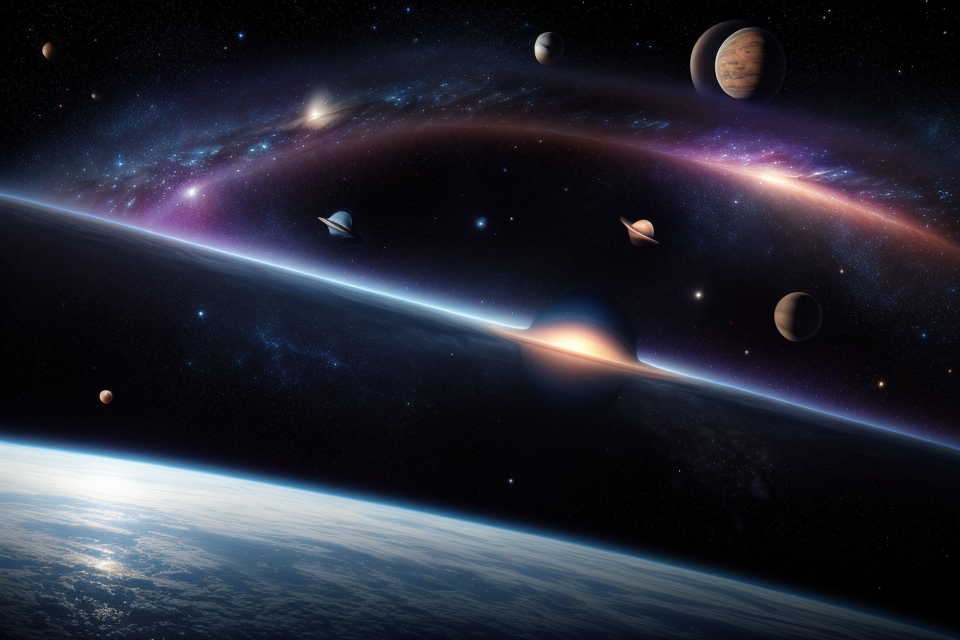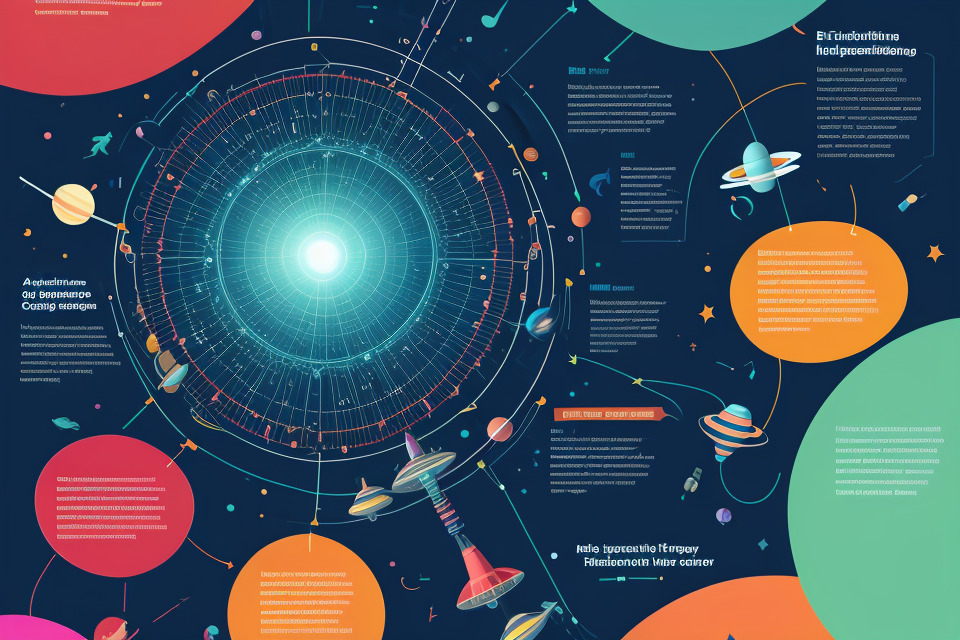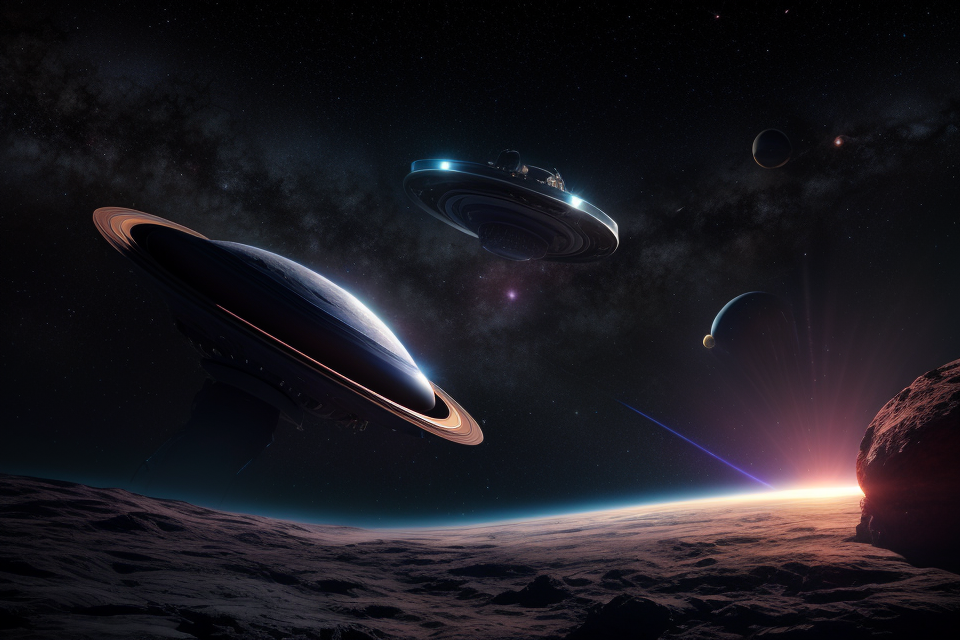Astrobiology, the interdisciplinary field that combines astronomy, biology, and planetary science, has captivated the imagination of scientists and laymen alike. With the recent discoveries of exoplanets and the ongoing search for extraterrestrial life, the question of where astrobiology is located has become increasingly relevant. This field is not limited to a specific location or institution, but rather spans across the globe, with researchers from diverse backgrounds and disciplines working together to unravel the mysteries of life in the universe. From the deserts of Mars to the depths of the ocean, astrobiologists are exploring every corner of the cosmos to understand the potential for life beyond Earth. Join us as we delve into the fascinating world of astrobiology and discover where it is located.
What is Astrobiology?
Origins and History
Early Influences and Inspirations
The roots of astrobiology can be traced back to the early days of human civilization, when ancient cultures gazed up at the night sky and pondered the mysteries of the cosmos. From the earliest cave paintings to the most advanced telescopes, humans have been captivated by the beauty and complexity of the universe. This fascination with the stars and planets has driven many to explore the possibility of life beyond Earth, and has inspired countless scientists, philosophers, and writers to imagine what life might be like on other worlds.
The Emergence of Astrobiology as a Scientific Discipline
It was not until the 20th century that astrobiology emerged as a distinct scientific field. In the years following World War II, scientists began to develop a deeper understanding of the origins and evolution of life on Earth, and to consider the possibility that life might exist elsewhere in the universe. This led to the development of new technologies and research methods, such as space exploration and the search for extraterrestrial intelligence (SETI), that enabled scientists to study the origins and evolution of life in new and exciting ways. Today, astrobiology is a rapidly growing field that encompasses a wide range of scientific disciplines, from astronomy and planetary science to biology and chemistry.
In recent years, astrobiology has made remarkable progress in our understanding of the universe and the possibility of life beyond Earth. The discovery of exoplanets, or planets that orbit stars outside of our solar system, has opened up new avenues for the search for life beyond Earth. Advances in technology have also enabled scientists to study the chemical and biological properties of extraterrestrial environments, and to simulate the conditions of early Earth to better understand how life might have arisen on our own planet. As the field of astrobiology continues to evolve, it remains at the forefront of scientific inquiry into the origins and future of life in the universe.
The Goals of Astrobiology
Astrobiology is a field of study that seeks to understand the origin, evolution, distribution, and future of life in the universe. It combines elements of biology, astronomy, geology, and other sciences to explore the question of whether life exists beyond Earth, and if so, what the implications of this might be. The goals of astrobiology can be divided into two main areas:
Understanding the Origin and Evolution of Life in the Universe
One of the primary goals of astrobiology is to understand how life originated on Earth and how it has evolved over time. This involves studying the early history of the planet, the origins of life itself, and the various factors that have shaped the evolution of life on Earth. Astrobiologists seek to identify the conditions that are necessary for the emergence of life, and to understand the processes that have allowed life to persist and evolve over billions of years.
Searching for Habitable Environments and Extraterrestrial Life
Another key goal of astrobiology is to search for habitable environments and extraterrestrial life beyond Earth. This involves searching for planets and moons that might be capable of supporting life, as well as studying the chemical and physical conditions of these environments. Astrobiologists use a variety of techniques to search for signs of life beyond Earth, including the detection of biosignatures (such as the presence of oxygen or methane in an atmosphere), the search for extraterrestrial microorganisms, and the exploration of subsurface environments that might be capable of supporting life.
In addition to these two main goals, astrobiology also seeks to understand the broader implications of the existence of life beyond Earth. This includes questions about the potential for life to spread between different planets and moons, the possibility of extinction-level events that could wipe out all life in the universe, and the long-term future of life in the universe. By exploring these questions, astrobiologists hope to deepen our understanding of the cosmos and our place within it.
Astrobiology in Our Solar System
The Search for Habitable Worlds in Our Solar System
Mars: The Red Planet
Mars, also known as the Red Planet, has long been a focus of interest for astrobiologists due to its similar size and proximity to Earth. The planet’s geological features, such as its vast canyons and volcanoes, suggest a history of water on its surface, raising the possibility of past or even present life. Mars has a thin atmosphere, which makes it difficult to maintain stable conditions for life, but scientists continue to explore its potential for habitability.
Europa: A Potentially Habitable Moon of Jupiter
Europa, one of Jupiter’s moons, is another promising location for the search of habitable worlds. The moon’s surface is primarily composed of water ice, and it has a thin atmosphere, similar to Mars. Europa’s subsurface ocean, which is believed to be in contact with its rocky core, is thought to be the most likely location for potential life. The ocean is likely to contain a mixture of saltwater and dissolved compounds, which could create a unique chemical environment suitable for life. The Europa Clipper mission, scheduled to launch in the 2020s, aims to investigate the moon’s subsurface ocean and potential habitability.
Enceladus: A Surprisingly Active Moon of Saturn
Enceladus, a moon of Saturn, is another intriguing target for astrobiologists. It is the smallest and least massive body in our solar system that has its own magnetic field. This magnetic field, combined with its subsurface ocean, suggests that Enceladus has a unique environment that could support life. The moon’s geysers, which shoot water vapor and other compounds into space, are believed to originate from its subsurface ocean. Scientists have detected organic molecules in the plume, which further fuels the possibility of habitability. The Cassini mission, which studied Enceladus and its environment from 2004 to 2017, provided valuable data on the moon’s characteristics and habitability.
Overall, the search for habitable worlds in our solar system involves exploring diverse environments, such as the subsurface oceans of Europa and Enceladus, the ancient lake beds of Mars, and other potential locations. Astrobiologists continue to use cutting-edge technologies and research methods to better understand the conditions and environments that could support life beyond Earth.
Astrobiology Missions in Our Solar System
Current Missions: Unveiling the Secrets of the Cosmos
There have been several astrobiology missions in our solar system that have contributed significantly to our understanding of the potential for life beyond Earth. Some of the current missions that are unveiling the secrets of the cosmos include:
- NASA’s Mars Reconnaissance Orbiter (MRO): This mission has been exploring Mars since 2006, searching for signs of water and studying the planet’s geology. The MRO has provided valuable insights into the potential habitability of Mars and the search for past or present life on the planet.
- NASA’s Curiosity Rover: Launched in 2011, the Curiosity Rover has been exploring the surface of Mars, searching for signs of life and studying the planet’s geology and climate. The rover has found evidence of past lakes and rivers on Mars, which suggests that the planet may have had a more hospitable environment in the past.
- ESA’s Rosetta Mission: This mission explored the comet 67P/Churyumov-Gerasimenko, studying its composition and structure. The mission provided valuable insights into the formation of our solar system and the potential for the presence of organic compounds on comets, which could be a building block for life.
- NASA’s Cassini Mission: This mission explored Saturn and its moons from 2004 to 2017, studying the planet’s atmosphere and the potential for life on its moons. The mission provided valuable insights into the potential habitability of Enceladus, one of Saturn’s moons, which has a subsurface ocean that could harbor life.
These missions have contributed significantly to our understanding of the potential for life beyond Earth and have opened up new avenues for further exploration and research.
Astrobiology Beyond Our Solar System
The Search for Habitable Exoplanets
Detecting Exoplanets: The Quest for Other Worlds
Detecting exoplanets is a complex process that requires the use of various astronomical techniques. One of the most common methods is the transit method, which involves measuring the slight dimming of a star as an exoplanet passes in front of it. Another method is the radial velocity method, which measures the wobbling motion of a star caused by the gravitational pull of an orbiting planet.
The Habitable Zone: The Goldilocks Zone for Exoplanets
The habitable zone is the range of distances from a star where an exoplanet can have the right temperature to support liquid water on its surface. This zone is determined by the amount of heat received from the star and the amount of heat that can be lost to space. The habitable zone is often referred to as the “Goldilocks zone” because it is the range of conditions that is just right for life to exist.
Exoplanet Characterization: The Search for Life Beyond Earth
Once exoplanets have been detected and their location in the habitable zone has been determined, the next step is to characterize them. This involves studying their atmospheric composition, size, mass, and other physical properties. Astronomers use various techniques to study exoplanets, including spectroscopy, which involves analyzing the light that is emitted or reflected by an exoplanet to determine its composition. Other techniques include imaging and spectrophotometry.
The goal of exoplanet characterization is to determine whether an exoplanet is capable of supporting life. This involves looking for signs of atmospheric gases that are indicative of biological activity, such as oxygen and methane. Astronomers are also looking for evidence of surface features that could indicate the presence of liquid water, which is essential for life as we know it.
As technology continues to advance, astronomers are becoming more confident in their ability to detect and characterize exoplanets. The search for habitable exoplanets is an exciting area of research that could potentially reveal the existence of extraterrestrial life and provide new insights into the origins of life in the universe.
The Search for Biosignatures: Fingerprints of Life
The Search for Oxygen: A Biosignature of Life
In the quest to detect life beyond our solar system, one of the most promising avenues is the search for biosignatures, or the distinctive chemical fingerprints that indicate the presence of life. One of the most well-known biosignatures is the presence of oxygen in an exoplanet’s atmosphere.
Oxygen is a byproduct of photosynthesis, the process by which plants, algae, and some bacteria convert sunlight into energy. On Earth, oxygen is produced in massive quantities by plants and phytoplankton, and it makes up a significant portion of our atmosphere. Therefore, the presence of oxygen in an exoplanet’s atmosphere could be a strong indication of the presence of life.
However, detecting oxygen in an exoplanet’s atmosphere is easier said than done. The first challenge is that oxygen is a highly reactive molecule, and it can easily be broken down into other molecules by chemical reactions in the atmosphere. Additionally, oxygen is not the only molecule that can be produced by non-biological processes, such as volcanic activity or meteorite impacts.
To overcome these challenges, astrobiologists are developing new technologies and techniques to detect oxygen in exoplanet atmospheres. For example, some researchers are using computer models to simulate the atmospheres of exoplanets and predict the presence of oxygen based on the planet’s size, temperature, and other factors. Others are developing new instruments and telescopes that can detect the faint signature of oxygen in the atmospheres of distant planets.
The Search for Methane: Another Clue to the Presence of Life
Another potential biosignature is methane, a gas that is produced by microbes on Earth. Methane is relatively easy to detect, as it absorbs specific wavelengths of light that can be detected from a distance. However, methane can also be produced by non-biological processes, such as geological activity or meteorite impacts.
To distinguish between biological and non-biological sources of methane, astrobiologists are studying the distribution and abundance of methane in exoplanet atmospheres. They are also studying the isotopic composition of methane, which can provide clues about its origin. For example, if methane on an exoplanet has a different isotopic composition than methane on Earth, it could be a sign that it was produced by a different type of life form.
Overall, the search for biosignatures is a promising avenue for the detection of life beyond our solar system. However, it is a challenging field that requires the development of new technologies and techniques to overcome the many obstacles that stand in the way.
Astrobiology and the Future of Human Space Exploration
The Impact of Astrobiology on Space Exploration
The Search for Life: A Motivation for Space Exploration
- Astrobiology has revolutionized the search for life beyond Earth, as scientists seek to understand the origins and evolution of life in the universe.
- The study of extremophiles, organisms that can survive in extreme environments, has expanded our understanding of the limits of life and has opened up new possibilities for the search for extraterrestrial life.
- Astrobiology has also provided valuable insights into the habitability of other planets and moons, allowing us to identify potential targets for future space missions.
Inspiring the Next Generation of Space Explorers
- Astrobiology has sparked a renewed interest in space exploration, particularly among young people, who are inspired by the possibility of discovering new worlds and the search for extraterrestrial life.
- This interest has led to an increase in the number of students pursuing careers in science, technology, engineering, and mathematics (STEM) fields, as well as an increase in public support for space exploration.
- Astrobiology has also opened up new opportunities for collaboration between scientists, engineers, and policymakers, as they work together to advance our understanding of the universe and our place in it.
The Challenges and Opportunities of Astrobiology
Overcoming Technological Challenges
One of the main challenges of astrobiology is overcoming the technological hurdles that stand in the way of space exploration. For instance, the long-term survival of human space travelers is a major concern, as extended stays in space can have detrimental effects on human health. Moreover, the need for sustainable sources of food, water, and air is another critical issue that must be addressed. Scientists are actively working on developing advanced life support systems and closed-loop ecological systems that can sustain human life during long-term space missions.
Building International Collaborations and Partnerships
Astrobiology is a global endeavor that requires collaboration among scientists, engineers, and policymakers from different countries. International partnerships are crucial for advancing our understanding of the universe and expanding human knowledge. The International Space Station (ISS) serves as a prime example of successful international collaboration in space research. The ISS has facilitated cooperation among more than 15 countries, enabling scientists to conduct research in microgravity and paving the way for future space missions.
Fostering Public Engagement and Education
Public engagement and education are essential components of astrobiology, as they help to inspire the next generation of scientists and space explorers. Educational outreach programs, science museum exhibits, and public lectures are some of the ways in which astrobiologists can engage with the public and promote the importance of space research. By sharing their knowledge and passion for space exploration, astrobiologists can help to cultivate a culture of curiosity and discovery that will drive the field forward for years to come.
The Enduring Allure of Astrobiology
The Unanswered Questions and the Future of Astrobiology
The enduring allure of astrobiology lies in the numerous unanswered questions that continue to intrigue scientists and the general public alike. For instance, the search for extraterrestrial life remains a top priority for astrobiologists, with many exoplanets and moons being explored for signs of habitability and potential microbial life. Additionally, the study of the origin and evolution of life on Earth, as well as the search for biosignatures on other celestial bodies, are also areas of active research.
Furthermore, astrobiology also encompasses the study of the environmental factors that shape the habitability of planets, such as the role of atmospheric composition, temperature, and radiation. Understanding these factors is crucial for assessing the potential for life on other planets and moons.
The Importance of Continued Research and Exploration
The allure of astrobiology also stems from the potential implications of its findings for humanity. The discovery of extraterrestrial life could have profound implications for our understanding of the universe and our place in it. Additionally, the study of life in extreme environments on Earth could provide valuable insights into the potential for life on other planets and moons.
Furthermore, astrobiology also has practical applications for human space exploration. Understanding the environmental factors that shape habitability could aid in the selection of target destinations for future manned missions. Additionally, the development of technologies for long-term human habitation in space could be informed by the study of extremophiles, organisms that can survive in extreme environments on Earth.
The Potential Benefits and Implications of Astrobiology for Humanity
The potential benefits and implications of astrobiology for humanity are vast and far-reaching. The discovery of extraterrestrial life could have profound philosophical and societal implications, challenging our understanding of our place in the universe and potentially leading to a renewed sense of global community. Additionally, the practical applications of astrobiology could have significant implications for human space exploration, leading to the development of new technologies and the expansion of human presence in space.
In conclusion, the enduring allure of astrobiology lies in the numerous unanswered questions that continue to intrigue scientists and the general public alike. Its potential benefits and implications for humanity are vast and far-reaching, and its continued research and exploration is of utmost importance for our understanding of the universe and our place in it.
FAQs
1. What is astrobiology?
Astrobiology is the study of the origins, evolution, distribution, and future of life in the universe. It encompasses a broad range of disciplines, including biology, astronomy, planetary science, and more. Astrobiologists seek to understand how life might arise and persist in different environments, including those on other planets and moons within our solar system and beyond.
2. Where is astrobiology located?
Astrobiology is a field of study that spans across many disciplines and institutions. While there isn’t a single location where astrobiology is exclusively practiced, researchers from various fields contribute to the development of astrobiology. Research in astrobiology can be conducted in universities, space agencies, and research institutions all around the world. Some prominent centers for astrobiology research include NASA’s Ames Research Center, the University of Edinburgh, and the European Space Agency (ESA).
3. What kind of research is conducted in astrobiology?
Research in astrobiology covers a wide range of topics, including the search for extraterrestrial life, understanding the conditions required for life to exist, and the study of extremophiles (organisms that can survive in extreme environments on Earth). Astrobiologists study the evolution of life on Earth, the origins of the solar system, and the potential habitability of other planets and moons. They also investigate the impact of space travel and space radiation on living organisms. In essence, astrobiologists are explorers of the cosmos, seeking to understand the mysteries of life beyond our planet.
4. How is astrobiology related to the search for extraterrestrial life?
The search for extraterrestrial life (SETI) is a major focus of astrobiology research. Astrobiologists employ a variety of techniques to search for signs of life beyond Earth, such as radio and optical astronomy, astrochemistry, and planetary exploration. They study the atmospheres of exoplanets for signs of industrial activity, looking for signs of biological processes, and analyzing the composition of extraterrestrial materials for evidence of life. While we have yet to find definitive proof of extraterrestrial life, astrobiologists continue to refine their techniques and broaden their search in the hope of one day making a groundbreaking discovery.
5. What kind of impact could astrobiology have on our understanding of life in the universe?
Astrobiology has the potential to significantly expand our understanding of life in the universe. By studying the conditions required for life to exist, we can learn more about the potential habitability of other planets and moons. This knowledge can help guide the search for extraterrestrial life and inform the design of future space missions. Furthermore, astrobiology can help us understand the evolution of life on Earth and its potential fate in the future. It also has the potential to inspire new technologies and approaches for addressing challenges on Earth, such as developing ways to survive in extreme environments.



